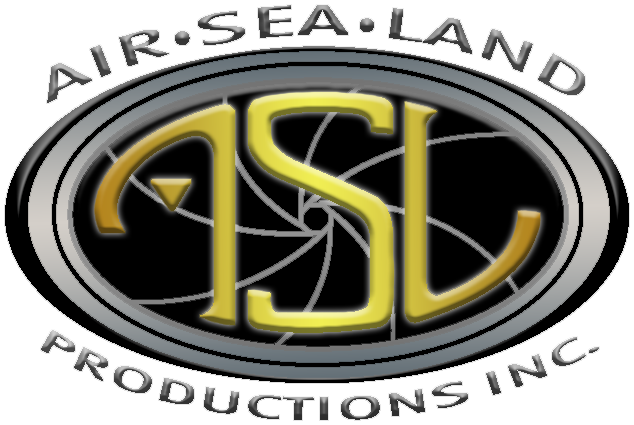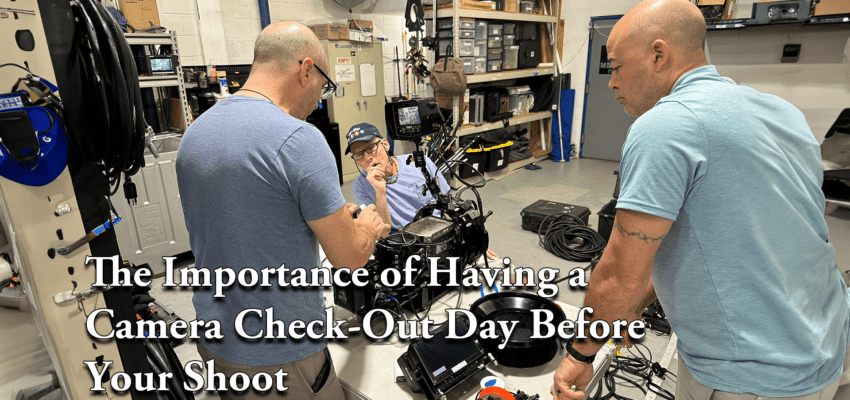With 30 years of experience, we understand that filmmaking can be challenging. Shooting underwater? Now that’s an entirely different story. There are many challenges involved in this specialized form of filmmaking.
Achieving success on set isn’t solely about the shoot day itself; it’s about meticulous planning during pre-production as well. This post explores the crucial role of a camera check-out day in underwater shoots and provides insights into the behind-the-scenes process.
Camera Check-Out Day
A camera check-out day prepares your camera and underwater housing for shooting a day before it’s needed. It’s important to make sure that the lenses fit within the housing, the gears line up on your lenses, and that you have full control over focus, iris, and zoom. We also make sure the housing does not obstruct the camera’s view and create vignetting around the edges of the shot
The Benefits of Having a Check-Out Day
Having a camera check-out day reduces downtime, minimizes technical issues on shoot day, and ensures optimal performance underwater.
- Time: Assembling the camera and housing typically takes up to 1.5 to 2 hours. Having a check-out day means the camera is ready to go as soon as it arrives on set. No time is wasted.
- Troubleshooting: Since Air Sea Land is the largest rental house for professional underwater camera gear in the North East, we have everything you need to address potential problems before you get to set. If there are issues getting the camera and lens package into the housing on check-out day, we have time to change lenses and make the necessary adjustments to ensure a successful shoot.
- Performance: Once we confirm the seals are water tight, we balance the housing in our tank to ensure it is neutrally buoyant. This means the housing stays put in the water; it is the best case scenario for the operator and crucial if you want to get the best shots possible.
Beyond the advantages of minimizing downtime and technical glitches, a check-out day offers a unique opportunity for those last-minute adjustments that can make a world of difference. It’s the peace of mind that comes from knowing that your equipment has been rigorously checked and the confidence gained knowing your camera is ready to go.
The Disadvantages of Forgoing a Check-Out Day
Choosing not to have a check-out day can result in a number of issues while on set.
- Buoyancy: If the housing is not neutrally buoyant, it will either sink or float. If it is buoyant, the operator will have to pull the housing down for the duration of the shoot. If it is negatively buoyant, the operator will have to hold the housing up. If the housing rolls to either side, the operator must fight against that as well. This will affect the outcome of your shots.
- Lens Difficulty: If the lenses you have on set do not fit in the housing, the underwater shots you want will be impossible to shoot. If the lenses fit but create a vignette in your shot, your desired outcome will be very difficult to meet.
- Incompatible Accessories: If the focus motor does not physically fit within the housing, or you realize you need another accessory in order to make it work, there is limited time for error correction. If you need a new piece delivered to set, your production cost will go up.
When production companies skip on hiring a technician and/or operator, their production
day is typically extended or certain shots are dismissed. This is because of the
additional technical time consumed.
What To Expect on Check-Out Day
- Duration: A typical check-out day is a half day of labor — around 4 hours maximum. Duration is subject to change depending on the housing chosen.
- Process: An experienced camera technician builds the camera and housing, completes all necessary tests for you, and makes adjustments to the equipment based on their assessment.
- Attendance: It is best to have an Assistant Camera (AC) present to ensure the camera settings are correct before going into the housing. When the camera enters the housing, the focus and iris markings on your lens will no longer be visible. The AC can use this time to make focus and iris marks on the controls so they are able to pull focus while on set.
If you decide against hiring one of our experienced camera technicians on your check-
out day, we will assist in answering any questions you may have about the housing.
Maintenance and Care
When housings return to our shop, and before they are rented out again, we inspect
multiple aspects of the equipment to maintain longevity. This process allows our
housings to be ready for the next filmmaker’s production.
- Seals and O-Rings: We make sure the seals are secure and do not allow any water into the housing. We check the O-rings for any irregularities and lubricate them upon each return.
- Pressure Tested: We pull a vacuum to make sure air does not seep into the housing.
- Sediment: We check for sand, salt, and dirt. If our housings are not properly cleaned while on set, our camera technicians rinse and clean them thoroughly. This is an additional labor cost.
This maintenance process is a necessary step we take to provide the best possible
tools for your underwater productions.
We’re Here to Help
Our 30 years in the film and television industry have shown us that underwater filmmaking presents abundant challenges, with little margin for error. Meticulous preparation can be the difference between a shoot that flows smoothly and one that turns into a filmmaker’s nightmare.
A camera check-out day is a critical step that ensures your camera and underwater housing are in peak condition and ready for production. It minimizes downtime and technical issues on the actual shoot day.
Whether you’re a seasoned underwater operator or embarking on your first underwater shoot, we invite you to reach out to us. When you schedule a camera check-out day with Air Sea Land, our commitment to ensuring your productions go off without a hitch will shine through.
You can contact our team for more information via:
Website: airsealand.com
Telephone: +1 (718) 626.2646
Email: info@airsealand.com or rentals@airsealand.com



